Francesca and Henk-Jan's Backpacking Trip!
Friday, November 13, 2009
Indonesia On The Run
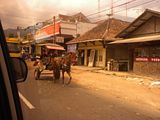
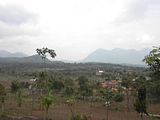
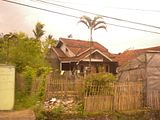
Outside of the ‘small cities,’ as Budi put it, with only 1 million inhabitants, I saw many of the familiar rice fields. After a few hours Budi had Topik stop at a particularly scenic hillside, where Francesca and I hopped out to take pictures of the unsuspecting locals and their fields. Everything looked so lush and green, and for a second we wondered if we had entered paradise. I climbed down the hill a little to the ruins of some old house to take some more pictures. Covered in cobwebs I managed to get some great shots through the windows.
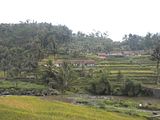
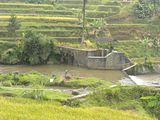


Another two hours later we arrived at ‘Kampung Naga,’ a traditional Sundanese village, where people still live the ancient way, without electricity. A kind old man took us down a long staircase, showing us an overview of the small group of houses. He told us the name of the village derives from the river that meanders around it: with its many turns and twists it reminded the first Sundanese of a dragon, and therefore they called their village ‘Dragon Village’ or ‘Kampung Naga.’
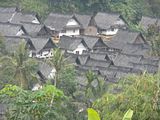
A few more steps later we were at the same level as the village and the old man showed us a local plant that, when threatened, rolls itself up. He held a lighter near a few leaves and sure enough we saw the leaves fold together one by one. As we walked towards the village we saw people working the rice fields. The village is self-sustaining, so a good rice harvest means the world to them. The rice definitely looked like it was being taken good care of.

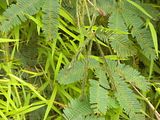
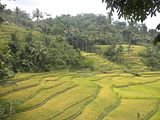

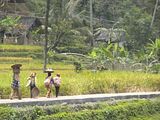
Entering the village we could really see the way the village had been set up. Little pathways led to the bamboo-houses, and either side of the path would have a water basin next to it with fish in them. Some of the basins had toilets hovering over them. I asked if that didn’t ruin the fish, but the man said that the fish were moved from these basins to clean ones before consumption.

Other than fish, there were also loads of chickens roaming around, and here and there we found some goats and sheep locked away. Big bamboo plates covered with drying rice were also laying around everywhere. Since the chickens would eat the rice if they had the chance, some of the older ladies had long sticks with plastic bags attached to them, which they used to scare off any hungry fowl.
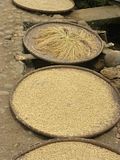
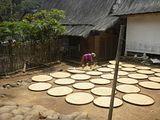
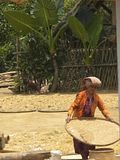

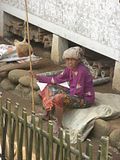
Walking through the village we got to see the houses up-close. The old man explained that the houses were really basic, but well thought-out. The kitchen is located in a separate room with much more loose bamboo to make sure the smoke can get out. The rooftops are used for drying laundry. The only means of income for the villagers is the handicraft they make out of bamboo in their spare time. Some of the richer villagers cheat and have purchased radios and TVs that run on batteries, and two of them even have a car.
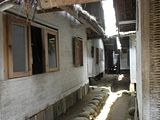

The man also explained how the village would never grow. The amount of houses that stand now will never be expanded and only some of the kids get to stay when they’re adults. There’s simply not enough space for all of them. We did see a bit of construction going on, as the villagers were building a new house for the chief. A communal effort and nothing fancier than any of the other buildings, the construction would take quite a while.
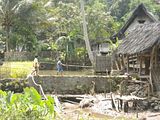
At the end of our Kampung-tour we were invited to have a look inside the man’s house. Francesca and I took our shoes off and entered the tiny residence. The wife was cooking fish when we came in, and it smelled fantastic. Francesca thought the fish looked dodgy, but I wouldn’t have minded to give it a try. The next room was the ‘living room,’ which basically meant there was space for 1 TV, some handicraft and some western furniture, like a Guinness-clock. Very random! The bedroom looked very basic and we certainly would have had a hard time sleeping in the guestroom: it had two ‘mattresses’ of bamboo.

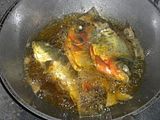
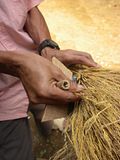
Walking back towards the car we saw some pineapples. The plants were very young, so there was no chance for me to try any of it. We did get to sample another local fruit though: ‘lasak’ is a small light green fruit with a mildly sour tasting skin and a brittle white core. The skin was certainly the most edible part, but I’m not sure how well this fruit would do in the supermarket.
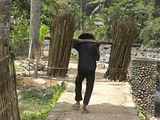
Before leaving I purchased a little bracelet for myself, hoping to start a collection of cool accessories to be acquired during our trip. The rest of the day was unfortunately spent driving. We did not get into Baturaden until after sunset. We had had a hard time finding a hotel in Baturaden, and kind of gambled by booking the Queen Garden Hotel. The place looked okay when we first entered, but our budget room was actually in the Queen Motel, and was downright nasty. It had no AC, had not seen any cleaners in a very long time and there was a large assortment of bugs present. We decided to stick with the budget room, because we did not want to spend much more money on a room for one short night. We watched Home Alone II and went to sleep.
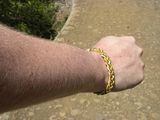

In the morning of the 11th we packed up and had a shower in the not-too-clean bathroom; at least the water was hot. Feeling slightly better and cleaner we jumped in the car and were ready for another long day in the car. Yogyakarta in Central Java was our next target and we had 10 hours to go.
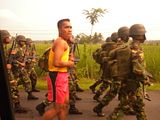
After an hour or so Topik pulled over and Budi took us to a large stack of bricks by the side of the road. The soil here is apparently extremely suitable for brick making and the locals do a great deal of it. We saw how they work in a rotation system where one person is digging up the soil; another is putting the mud in wooden molds, flattening it perfectly before making the next one; and the next person is working on a set of bricks that has dried enough to be stacked up. After this process the bricks are burnt to give them the strength they need to one day be part of a house.
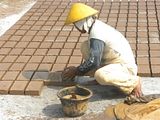
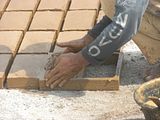
Budi also told us how they make less than $2 per day, starting at 6:00AM and working until the afternoon, and then moving on to work on the rice fields. It’s a good thing they can live off that money – it’s a life of hardship already!
Driving onwards Budi told us we were heading for the Dieng Plateau. We had already felt we were climbing, as our ears kept popping. The landscape had changed from rice fields to cabbage and potato fields. Funny enough, the locals hardly eat any cabbages at all and most of their harvest is sold elsewhere. Budi took us to a viewpoint of the valley below us, showing us how varied and different the scenery here was. We also got to see some batik-art. Batik is a sort of wood that grows with designs in it and therefore requires far less work, for a far nicer result.
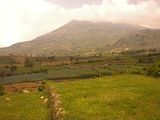
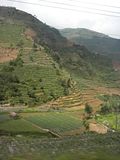
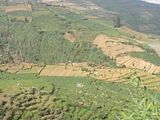
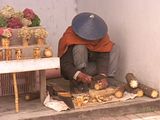
We stopped in Wonosobo for lunch. Stepping out of the car I noticed it had gotten a lot colder. Our driver and guide were rubbing their arms and grabbing their jackets. Francesca and I went inside and inspected the menu. I opted for the Mie Goreng (fried noodles with chicken) and Francesca really wanted to try the banana pancake. When the waiter told us it would take 30 minutes for it to be ready she knew she was in for a treat. My Mie arrived much faster and since we were both hungry I shared it with Francesca who was quite happy to fish out pieces of chicken. It tasted fantastic!

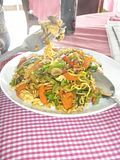
Francesca’s pancake was quite the treat also. The thing must have been at least 6 cms/2” high and took up a whole plate. Francesca couldn’t wait for the first bite and I cut her the first slice. Even between the two of us, we couldn’t finish the pancake and had to take a few slices away. Budi said he would take us to see an ancient 9th century Hindu Temple. The temple, or ‘Candi Pandawa’ had unfortunately mostly been destroyed and the parts that were still standing looked like time had gotten the best of it. The stone carvings were barely recognizable, which is a major shame.
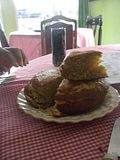
We did see that some of the houses are still in use, because they were covered in colorful petals. The main temple had carvings of Ciwa, Vhisnu and Ganesa on the different sides still looked in okay shape. We were allowed to enter and I found out how small these people really are and must have been. I barely fit through their doors! The backdrop for the temple was possibly more impressive than the temple itself, with cloud-covered mountains that looked majestic in the serene presence of the temple.
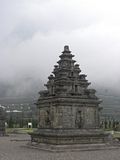
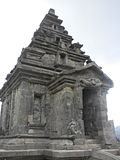


Topik had moved the car to the other side of the temple, so we continued our walk through the colorful fields. Some kids were playing with the ‘lamp flowers,’ drinking the liquid out of the young flowers. Budi asked if it was ‘manis’ (sweet) and the kids nodded. Budi tried and found it wasn’t very sweet at all. The kids laughed and Budi gave them a sour smile. The flowers had just collected dew and could be used to quench a bit of thirst! I tried a few as well and managed to convince Francesca to give it a shot too. She was a bit scared, but managed to get a few drops in her mouth.
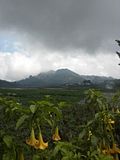
Budi walked us over to yet another Hindu temple, which looked similar to the other examples we had just seen. This one was a little bigger, but that just means it’s surrounded by more fallen bricks and rubble. Francesca and I found the view of the valley, with a large lake, much more interesting. Nature just looked so lush here, and we realized we were very glad to be out of the city.
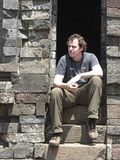
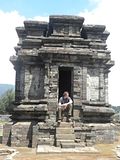
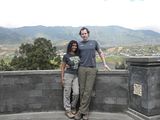
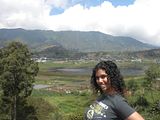
Since Indonesia is so volcanic, it is no surprise there’s plenty of sulphur springs around as well. Budi took us to one and after exiting the car we remembered the smell from good old Rotorua. The landscape around us suddenly looked very barren and the ground was covered in sulphur. The spring was quite big and large amounts of steam were pushed away by the wind. Budi suggested we’d walk around it, so we started walking into the steam, which immediately fogged up both our glasses. Not seeing a thing we found our way out, only for me to send Francesca back in for some action shots and a bit of a laugh.
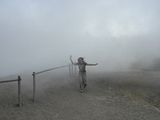
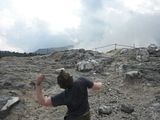
On our way back I asked Francesca to jump on my back, because the poor girl looked a little tired from her adventures. As I ran her back to the car we were cheered on by some local women, who started singing a song as we came past.
Not quite done with the Dieng Plateau we also hopped over to the color lakes, which get their name from the sulphur in the water. We walked towards the lake, and Budi told us the local Hindi still consider the place sacred. There were several statues and some closed off caves used for ceremonies. I have to admit, the water did not look that stunning and we were satisfied taking a few pictures on a log that stuck out into the water.

Francesca had been much more interested in a monkey, which had greeted us at the entrance to the park. Francesca remarked that it looked very human and that she’d never seen a monkey up-close like that. I thought it was pretty sad, having a monkey on a short chain when it should obviously be allowed to climb around freely and enjoy life. It certainly looked very unhappy with its current state.
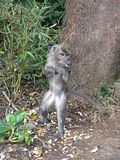
Our sightseeing day was not quite over yet! Our biggest treat yet was still to come: Borobudur. It took us until 3:30PM to get to Borobudur and we only had until 5:00PM to explore the world’s largest Buddhist temple. Luckily we could get a guide for no more than $5, so we obviously took one with us. Both of us knew pretty much nothing about Borobudur, but just seeing it from a distance we were really impressed.

Walking up the stairs and getting much closer to the structure we started to realize the complexity of it. The construction of Borobudur had started in the 8th century, and it had taken three local sultans and 100 years to finish it. The first sultan’s architect had come up with the plans all by himself, but since he did not live to see the end result several others were employed to work on it. Inspiration was taken from different temples in India and artists from all over the world came over to sculpt bits and pieces of the temple. We were amazed how harmonious it all looked.
Our guide then told us about the ten layers of the temple, each with a different purpose, and a different realm of Buddhism. The first level, or ‘Kamadatu,’ was solely dedicated to the material world, the world of the common people. We got to see several reliefs of stories of their lives, the dangers and challenges they had to face to reach the higher levels of life. For example: it showed pictures of people dancing, enjoying massages, drinking alcohol; all things the ‘better’ Buddhist would abstain from.
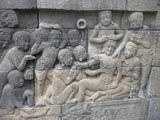
The 2nd to the 5th level, or ‘Rupadatu,’ were solely dedicated to the life of Prince Sidhartha, who later became Buddha. These levels are dedicated more to the monks, members of the spiritual world. The reliefs went all around the huge temple, but we were only allowed to see parts of it. Scientists are still studying the many blocks of lava stone to trace the history of the sculptor. Our guide also told us that holding your breath whilst reading a section from corner to corner was a good way of meditating. As the reader would walk around and repeat (again, repetition) this step it would bring him/her closer to the last level.
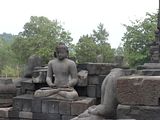
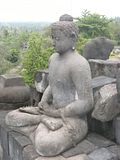
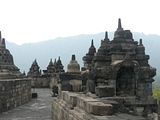
The 6th to the 10th level, or ‘Arupaduta,’ were all devoted to the highest level a Buddhist can achieve: ‘Nirwana.’ Every level had a circle of large Buddha-statues, totaling 72 life-size sculptures. 70 of them were covered in a so-called ‘Stupa,’ that looked like bell-shaped covers; the other 2 faced opposite directions and signified sunset and sunrise. Interestingly enough, the large dome on the last level no longer has a Buddha in it. It used to have one the same size of the other ‘stupas,’ but it had been taken down to a museum and has never been returned. The final Buddha was supposed to represent 'perfection' (nirvana) and since no one knows what perfection looks like, that Buddha's face, body, and details remained unfinished on purpose by the Buddhists.
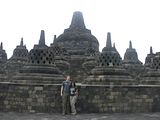
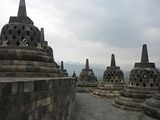
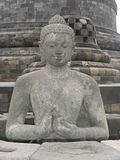
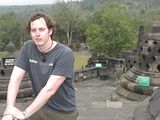
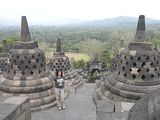
This seems a recurring problem for Borobudur as our guide told us with a sad face that many of the original total 0f 504 statues had been taken by treasure hunters, scientists and museums all over the world, and that many of them have never been returned. Our guide feared many would never come back either, due to diplomatic standings with certain countries. Our guide also shared that the local Buddhists no longer consider Borobudur sacred. Due to earthquakes and heavy tourism there’s even a real danger of further decay. We felt disheartened that we were part of this process, and angry at people that showed even less respect by climbing on walls and touched statues. We could not believe some people could be so inconsiderate. We at least respected the custom of walking around the dome an uneven number of times, in our case 7 (hurray for repetition!), something that Buddhists believe strengthens meditation.

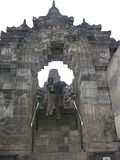
Around 5:00PM our guide took us back down to a large viewing area of Borobudur. He told us that there were still unanswered questions about the temple. For example, they do not know whether Borobudur was always the original lava stone color, or if it had once been painted white. We could only imagine how amazing that must have looked. Furthermore, he told us it was possible Borobudur had been built in the middle of a lake. Soil is still being researched to see how likely this is, but evidence has been found showing it could have looked that way once. Again, looking at the state of Borobudur now, and seeing it renovated and whitened in the middle of a lake, Buddhists could not complain about their new temple back in the day.
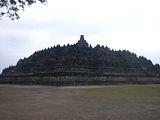
Our guide took us back to Budi and Francesca and I thanked him dearly for the enthusiastic commentary he had provided with. The final stop for us for that day was Yogyakarta, the capital of central Java. We trusted Budi enough by now (and the internet too little) to let him find us accommodation for the coming two nights and eventually we were dropped off at a nice place called ‘Metro’ on a quiet side street. Our room was basic, but had AC and looked cleaner. Budi had also told us of a good place to eat, so after unpacking a little we headed over to Via-Via.
We heard and saw that this little restaurant is very popular with tourists, as they have a rather varied cuisine, which makes for a nice change in such a rice-dominated country. Francesca and I were curious to try a chicken in pineapple appetizer, which definitely hit the spot. I tried a mango-pineapple milkshake, but wasn’t too fond of the flavor. Francesca had had a craving for Spaghetti Bolognese for a while now and a stack of Indonesian style garlic bread kept her smiling throughout dinner. I opted for the dish of the day; a vegetable nasi in a very spicy sauce and combined that with a pineapple lassi. A great finishing touch to a long and rewarding day.
The 11th of November was dedicated to the exploration of Budi and Topik’s home city. Yogyakarta is quite unique in the sense that it is a city-province, and the only city that still has a sultan. Our first stop of the day therefore was the ‘Krotan,’ the sultan’s palace. Francesca and I scored ourselves a guide and off we went. We were shown many of the prized artifacts his line possesses and the gifts they got from other countries.
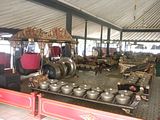
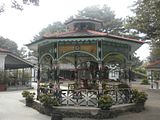
Here’s what our brochure has to say about the palace: “The Sultan’s Krotan, with its grand and elegant Javanese architecture, lies at the center of the municipality. It was built in 1775 by Pangeran Mangkubumi, whose son, the prince, was called Sri Sultan Hamengka Buwono I. The design of this historical building demonstrates that the palace, the Obelisks and Mount Merapi are positioned in one line. Many sets of Gamelan instruments, antiques, and heirlooms make the Sultan’s Palace one of the most interesting tourist sites in Yogyakarta.”
We learned how the previous sultan, Sri Sultan Hamengku Buwono XI studied in the Netherlands, before returning to Java. He had 7 wives and we went through a whole exhibit on these ladies. Francesca noticed how they all had such receding hairlines and that in the more official and ceremonial pictures they were wearing traditional wigs (which didn’t do much for them).
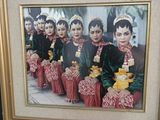
We also learnt how Sultan XI had passed away at the tender age of 73 a few years ago, and how his son Sri Sultan Hamengku Buwono XII is now the ruler of Yogyakarta. We learned how this guy showed much more modesty, taking only one wife, who happened to be a former model. Otherwise we just went through more memorabilia and pictures that were cool to look at, but not so interesting to write about.
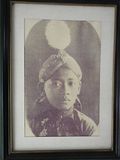
Note from Francesca: Henk forgot to mention that in the middle of walking around the Sultan's palace, we were mobbed by local elderly women "asking" (rather rudely by pulling and shoving us) to take pictures with us. However, we quickly realized they were far more interested in taking pictures of themselves with just Henk (those evil old women!) since they don't usually get to see such young, handsome, white boys. I glared at them, but I have to say it was pretty entertaining to watch how desperate they were!
Walking back towards the entrance our guide told us the palace is guarded by about a 1000 old men in traditional outfits, complete with ‘keris,’ the traditional dagger. Francesca wondered out loud whether these somewhat dusty fellows were the only security system present, and the guide responded that there was a more updated version present too. The old men just hang around because they have nothing better to do. Which helped us, because I want a picture with one of them!
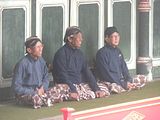
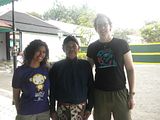
Budi had a little treat for us after the ‘Krotan’ and took us to a traditional Javanese market. What traditional meant we weren’t quite sure about, but shocking it certainly was. The first item for sale was a large bamboo plate with rice, covered in ants. Next to it we saw crickets, larvae and maggots -- all delicacies in certain countries and cultures. Past the snacks Francesca and I spotted a veritable zoo: people were selling dogs, cats, chickens, rabbits, geese, parakeets and fish. More jaw-dropping were the cages with withered owls, lace monitors, geckos and even bats! We could not believe our eyes. In fact, we could not believe our ears either when Budi told us all of these animals are eaten. Stir fried bat anyone?
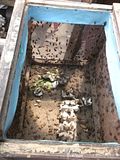
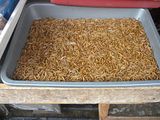
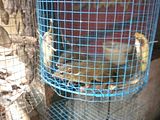
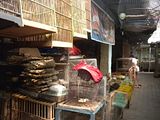
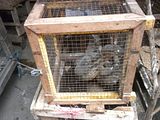
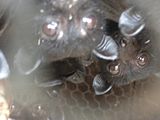
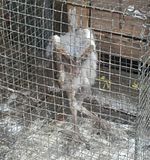
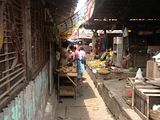
Following our display extraordinaire we were taken to a ‘batik’ workshop. ‘Batik’ is an old art form using beeswax, paraffin and a variety of colors of dye to color cloth and make paintings. Based on the technique used, ‘batik’ falls into one of three categories: hand waxing, hand stamping, or a combination of those two. Hand waxing is done with a tool called ‘chanting.’ We only saw one woman working on a hand waxed canvas, but the owner of the gallery showed us a large number of unique pieces that appealed to us a lot.
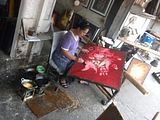
On the road to bigger things we stopped at a Muslim funeral parlor, where we saw a large array of gravestones lined up. The owner was working on some more additions to his already sizeable collection. We learned how Muslims aren’t buried in the slim, but coffin-like sculptures, but under. Next to the lava stone Budi took us to ‘Kota Gede’ Silverworks. During the reign of Sultan Agung there was much demand for gold and silver items. The name ‘Kota Gede’ derives from the town where most of the silver came from. We were shown incredibly detailed silver Borobudurs and even got a peak in the workshop, where 10 people were lined up making all sorts of silver jewelry.
After the silver and stones it was time for lunch. Budi and Topik took us to a little ‘warung,’ something a little smaller than a restaurant. Francesca got to order her long-awaited Sate Ayam (chicken satay), whilst I also got Songteng, a lamb-in-coconut-soup which tasted awesome. The Sate wasn’t very far behind and filled Francesca’s stomach up nicely. I was suggested the ‘Tape Panas,’ a fermented sweet rice drink, which didn’t sound good, but tasted fine. Francesca played it safe and ordered a Sprite. They actually ran across the street to get her one! Great service! And we paid less than $4 for all of it.

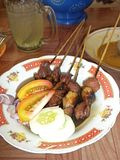
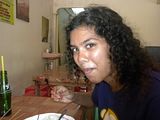
Inevitably, there was more exploring to do. Another huge temple called the ‘Prambanan Temple’ was on the menu. Francesca had already read about this temple, because it is famous for a ballet, which at certain times during the year is performed with the temple in the background. She had wanted to see this show and even though the temple was not part of the show, they still perform it every night on a stage. At least we’d get to see the temple during the day!
The sun was burning bright and we were melting like popsicles in an oven. Budi took us to a small temple, ‘Candi Sambisari.’ We had a look inside, but it all started looking the same. It’s just such a shame that they’ve all been destroyed to this extent and there’s no money to restore them. One interesting story about this temple Budi did share with us: the temple had been built in a giant hole in the ground, next to the rice fields. Over the centuries the hole had filled up with sand and eventually covered the entire structure, leaving it buried for many centuries. Unfortunately, this did not safe it from partial destruction, as Budi next showed us a large line-up of bits and pieces of statues and stones.
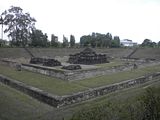
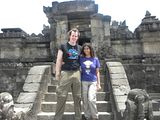
Next up: the ‘Prambanan!’ The first enormous notice we saw as we entered the ticket office read: “On the 27th of May 2006, at 5:50 W. Indonesian Time, a 5.8 Richter scale earthquake ran into Prambanan and its environs. The natural disaster has caused a lot of damage, among others the Prambanan Temple complex having been seriously damaged and still dangerous.” Indeed, many of the temples were covered in scaffolding and off-limits to tourists. The before and after pictures looked distinctly different! We were only allowed to enter a few of the buildings, which took a lot away from our experience.
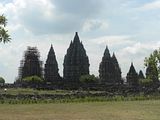
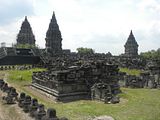
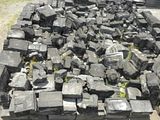
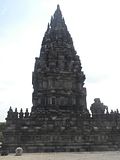
As a Hindu temple the main temple has three shrines, dedicated to the Hindu trinity: Ciwa, Vhisnu and Brahma. Each of these shrines faces a smaller shrine for their ‘vehicle.’ The cow or ‘Nandi’ is ‘Ciwa the destroyer God’s’ means of transportation. We were able to have a look inside and check out the sculpture of ‘Nandi.’ We noticed its horns were missing, and heard that they had been stolen by treasure hunters. How sad.
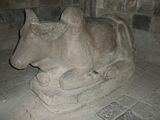
The other two vehicle shrines were for the eagle or ‘Garuda,’ the vehicle of ‘Vhisnu the guardian God.’ The last vehicle, the swan or ‘Angsa’ is the vehicle of ‘Brahma the creator God.’ Budi told us the whole temple had been built in the 9th century by the Sanjaya dynasty, and took over 50 years to construct. Due to the blistering heat and the lack of water Francesca and I sought refuge in the museum.
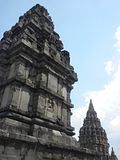
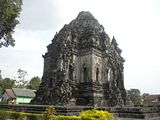
We learned how the Dutch had found Prambanan, and put a lot of money and effort into restoring it. They got a lot of work done over the years and definitely saved it from a worse faith. Francesca and I paid half a dollar each to see a video on the story that Prambanan’s temples tell: the story of Rama and Sinta. I’ll tell you more about that later. Tired of the heat and ready to relax a little we asked Budi to take us back to ‘Metro’ and pick us up later that evening to go to the ballet.
A few hours of AC blasting later we were re-energized again and excited to see the show. It only took half an hour to reach the car park. We had to stand in line for a while to get our tickets, trailing some mosquito net covered tourists. Still, we were amongst the first people to find seats and opted for two spots slightly to the side, but extremely close to the stage. Before the show started Francesca and I even walked backstage to have a quick look at the state of affairs there. It wasn’t too interesting so we sat back down.
At 8:00PM the show started with an introduction in several languages. We also saw the main actors in their exquisite costumes. We heard that the ballet we were about to see would tell the story of the struggle between good and evil. Rama, one of the many human forms of Brahma, his brother Laksmana and his wife Sinta, daughter of the earth have been banished into the forest. The evil king Rahwana wants to steal Sinta from Rama and tries to break their party. He sends a demon in the form of a golden deer to lure Rama away.
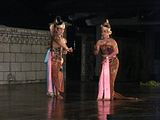
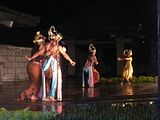
Rama follows the deer, but has a hard time catching it. In the mean time Sinta demands Laksmana go find his brother. Laksmana refuses at first and Sinta angrily says he wants her for himself. Laksmana is saddened by this accusation, cuts off his genitals and gets ready to leave. Before he goes he puts a magical barrier around Sinta, so she can’t be touched by evil.
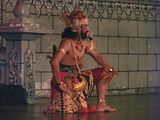
After Laksmana leaves Rahwana sees his chance and comes down to take her away. At first he can’t get through the barrier, but he tricks Sinta into stepping out by disguising himself as a thirsty old man. The king of the birds, Jatayu sees this happen and tries to stop Rahwana. Rahwana strikes Jatayu and disappears. Before Jatayu dies Rama and Laksmana find him and he tells them what happened with his dying breath.
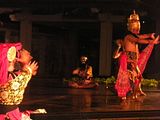
On their way to Rahwana’s palace they recruit the help of the Hanoman, the monkey king and in the end Rama and the monkey soldiers manage to kill Rahwana and take Sinta back. Rama fears Rahwana has touched Sinta’s purity and asks her to have a holy bath by jumping into burning fire. Sinta jumps into it, and Brahma comes down from heaven to put the fire out. All’s well that ends well!
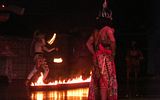
It took an hour and a half to put this all into dance, and Francesca and I were thoroughly impressed by it. We loved the Javanese style of dancing, which is very different from anything we’d seen before. The movement of the legs, whilst balancing on one foot is very important. Sometimes the pace would speed up, other times it’d look more like a play. I thought that the show would do very well on Broadway. After the show we heard it had been going nightly since 1976, with no plans of stopping in the near future.

A show has to include dinner, so we asked Topik to drop us off at Via-Via again, where we ate another tasty dinner. Francesca order herself a chicken, cheese, bacon and mushrooms sandwich and I ate fried chicken with a sweet mandarin sauce. First, an old man came in and played a weird instrument for a while. Then, a whole band followed and played too many too loud songs, whilst an extremely rude and screaming woman joined in. Yogyakarta was a very nice city and we felt a little sad to leave it behind, because we knew there was still more that we wanted to see and do.
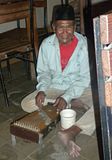
Yours truly,
Mr. Henk
